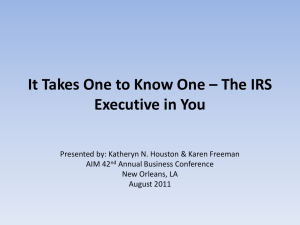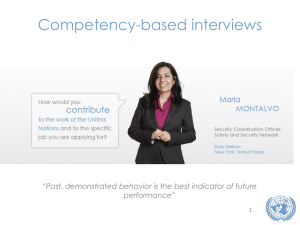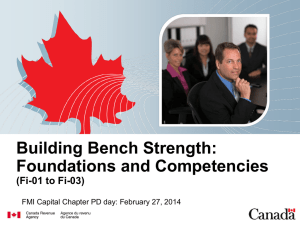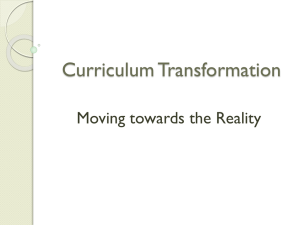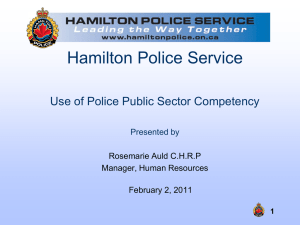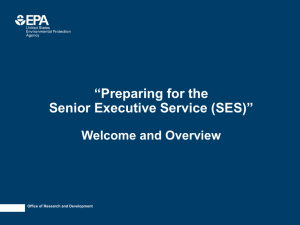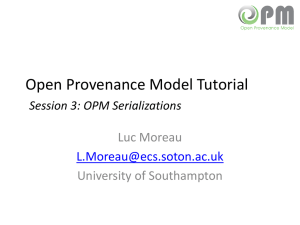Matthew Stafford
advertisement
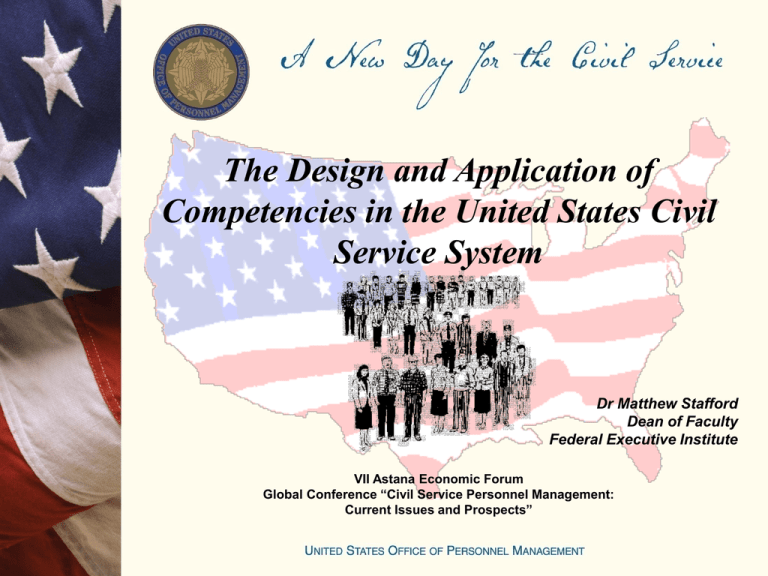
The Design and Application of Competencies in the United States Civil Service System Dr Matthew Stafford Dean of Faculty Federal Executive Institute VII Astana Economic Forum Global Conference “Civil Service Personnel Management: Current Issues and Prospects” Competencies in US Civil Service • Definition • The US Road to Competency-Based Human-Resource Manage • Selection • Development • Assessment • The “Competency Debate” • Leveraging a Competency-Based Management System to Effect Transformational Leadership Competencies Defined A competency is a measurable pattern of knowledge, skills, abilities, behaviors, and other characteristics that an individual needs to perform work roles or occupational functions successfully. • Key components of this definition: • Measurable • Includes knowledge, skills, abilities, behaviors and more • Specifically related to work to be performed US Road to Competency-Based HumanResource Management • 1991: Office of Personnel Management (OPM): • Initiated interagency discussion • Competencies nominated, reviewed, coordinated, selected • Spirited debate: specific competencies generally applicable • Personnel Resources and Development Center validated • 1992: OPM Published “Leadership Effectiveness Framework” • 22 Competencies • Subsequent validation work: benchmarking, research and collaboration; both public and private sector • 1997: Framework revised to address future needs • Extended far beyond knowledge and skills to include: • • • • Attitudes Values Behaviors Mindset Executive Core Qualifications (ECQs) • 1997: OPM assessed attributes of public and private-sector leaders, creating five ECQs • 1997-2008: ECQs became the baseline for selection to Senior Executive Service • 2012: ECQs became the baseline for SES assessment Executive Core Qualifications (ECQs) and Leadership Competencies ECQs and the Leadership Competencies Leading Change Leading People Results Driven Business Acumen Building Coalitions Creativity and Innovation Conflict Management Accountability Financial Management Partnering External Awareness Leveraging Diversity Customer Service Human Capital Management Political Savvy Flexibility Developing Others Decisiveness Technology Management Influencing / Negotiating Resilience Team Building Entrepreneurship Strategic Thinking Problem Solving Vision Technical Credibility Fundamental Competencies Interpersonal Skills Continual Learning Oral Communication Written Communication Integrity/Honesty Public-Service Selection • “Best Qualified” for non-SES positions • For SES selection, mastery of ECQs a precondition • Three methods • ECQ Narrative – ten-page explanation • Accomplishment Record – documentation of success • Resume-Based Application – supporting competencies explicated in traditional resume format • One 9-Step Process: The agency… 1. Selects Method 2. Advertises vacancy 3. Accepts applications 4. Reviews candidates 5. Interviews candidates 6. Has its Executive Resources Board recommend 7. Has its Appointing Authority review and approve 8. Submits candidates to OPM Review Board 9. Hires certified candidate Development • Three parts • Training • Education • Experience • Correlated to the… • Competencies for most civil servants • ECQs for SES members Strategic Thinking - Formulates objectives and priorities, and implements plans consistent with the long-term interests of the organization in a global environment. Capitalizes on opportunities and manages risks. Proficiency Level Proficiency Level Definition Proficiency Level Illustrations Level 5 - Expert • Applies the competency in exceptionally difficult situations • Serves as a key resource and advises others • Anticipates a demographic change in society and establishes a vision to effect change through formulation and implementation of objectives and priorities • Designs approaches and procedures to develop a strategic plan supporting key national goals and objectives Level 4 Advanced • Applies the competency in considerably difficult situations • Generally requires little or no guidance • Leads and directs a strategic planning team to address and outline the future direction of an organization • Establishes strategic performance measures to allow the organization to continually assess and adjust program direction Level 1 Awareness • Applies the competency in the simplest situations • Requires close and extensive guidance • Develops project teams and staffing plans based on consideration of strategic objectives • Ensures team objectives are consistent with strategic plan Training • Agency-specific Training – primarily aimed at “skills” Job skill-specific training o Schools o On-the-job Training General training o Schools o Online • OPM: “Trainer for the US Government” – primarily focused beyond skills In-house: The Center for Leadership Development o Eastern Management Development Center o Western Management Development Center o Federal Executive Institute External Market – Vendor Management Branch Education and Experience • Education Most educational needs met through recruitment No equivalent to US military colleges; however… o Cooperative programs with educational institutions o Center for Leadership Development (OPM) – Federal Executive Institute – Eastern Management Development Center – Western Management Development Center • Experience Senior Executive Service (SES) – Interagency (OPM Provides policy oversight) Below SES – Within single agency Assessment • For non-SES employees, performance assessment based on negotiated performance standards • For SES members, performance based on ECQs Critical Element 5. Results Driven (Minimum Weight 20%) Weight: _____ Agency Goals/Objectives for current FY: Must have at least 1 result (may have more than 5) This critical element includes specific performance requirements expected of the executive during the appraisal period, focusing on measurable outcomes from the strategic plan or other measurable outputs and outcomes clearly aligned to organizational goals and objectives. At a minimum, the performance plan will include performance requirements(including measures, targets, timelines, or quality descriptors, as appropriate) describing the range of performance a tLevel 3 for each result specified. It is recommended to also establish the threshold measures/targets for Levels 5 and 2. Alignment--cite relevant goals/objectives, page numbers, from the Strategic Plan, Congressional Budget Justification/Annual Performance Plan, or other organizational planning document in the designated section for each performance requirement specified. Performance Requirement 1: Strategic Alignment: The Competency Debate “As we begin the 21st century, evidence abounds that executive & leadership development has failed to meet expectations. … The “competency model” of the executive, proposing as it does a single set of competencies that account for success, must be supplemented with a development model based on leadership challenges rather than executive traits & competencies. Executive performance must focus on ‘what gets done’ rather than on one way of doing it or on what competencies executives have.” Competence, Not Competencies: Making Global Executive Development Work George P. Hollenbeck & Morgan W. McCall, 2003 An Analogy Leveraging a Management System to Effect Transformational Leadership Transactional Behaviors (Traditional Management) Monitoring and Controlling Discipline and Punishment Rewards and Incentives • Pay • Promotion • Required development Transformational Behaviors (Leadership) Selection for Special Developmental Opportunities Inclusion in Creative, Innovative and Problem-Solving Activities Mentoring and Coaching Better Communication • External Awareness • Contact with Stakeholders • Inspiration; Visioning Modifying Job Characteristics • Job Enlargement – Broader Responsibilities • Job Rotation – New Tasks • Job Enrichment – More Independence Review: Competencies in US Civil Service • Definition • The US Road to Competency-Based Human-Resource Manage • Selection • Development • Assessment • The “Competency Debate” • Leveraging a Competency-Based Management System to Effect Transformational Leadership Thank you Dr Matthew Stafford Dean of Faculty Federal Executive Institute

